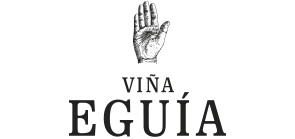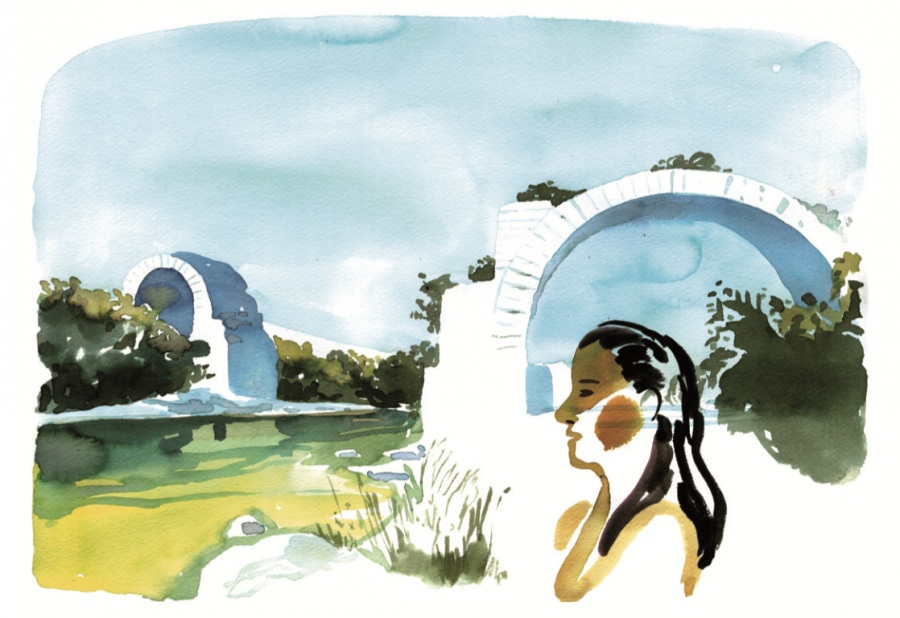
CHAPTER I
The Roman bridge
“Do you know on what side of the Ebro we arranged to meet? Because I haven’t a clue.”
For the umpteenth time in the last 300 kilometres Eva and Tom burst out laughing. With so much excitement they had forgotten to pinpoint the exact place where they were going to meet Stefan and Liv, who were coming from the opposite direction, from the north.
Three hours before, early in the morning, Eva had picked up Tom in Barajas airport. He had come from Chicago and it had been two years since they had seen each other last. During the car journey they had caught up with each other and now, a few metres from their destination, Eva realised that they hadn’t agreed on a meeting point.
“But didn’t we arrange to meet on a bridge? If Stefan and Liv come from the other side we’ll just cross over” said Tom laughing.
“There’s a small problem Tom. The thing is, this bridge has been in ruins for more than four centuries!”
As she spoke Eva pointed faraway towards a narrow and winding belt of bright green which stood out against the sea of vines. It was the poplars that were flanking the river Ebro. They were almost there.
They left the road and went along a dirt track up to the edge of a gully just where the vineyard stopped. They got out of the car.
Twenty metres further down the river flowed with its quiet force. On both sides of the river two huge stone arches emerged from the murmuring water. Firm and solid, always apart from each other, however always united by the Ebro and history. These two imposing structures were all that remained of the Roman Mantible bridge. For a very long time it was the crossing point for local farmers and travellers from afar, pilgrims and traders. Mantible had united the two parts of La Rioja.
Eva and Tom spent a while looking at the ruins. The first rays of sun bathed them in gold. The tranquillity and scent of rosemary and thyme permeated the June morning air. In the vine stocks the abundant leaves sheltered the grapes which were still small and in tight clusters.
“Everything you can see on the other side of the Ebro is Rioja Alavesa” Eva said. She had already been in the region and knew the area well. “It’s like a gentle slope which from here, from the river bank, gently rises between vines and small villages up to the Cantabrian mountains, that wall of forest and rock in the distance. The view from there is stunning, one day we’ll go up.”
“So this is where the reason for our journey originates...” Tom said whilst the horizontal movement of his arm marked out the extent of Rioja Alavesa.
“Yes, Eva said, these are the vines, these rural paths, these truly authentic villages and these wineries which are old and modern at the same time.” Enigmatically she added: “and, of course, it is home to the wine that we know. Shall we go for a dip?”
They picked up a couple of towels and went down to the river. The stones from the old bridge which remained on this side had formed a kind of calm and shallow pool away from the main river current. They had a swim and a quarter of an hour later, lying in the sun on one of the river bank rocks, they were already fast asleep.
The persistent sound of the mobile ringing woke Eva.
“Yes, hello?”
“At last! I’ve been calling you for ten minutes!”
It took her a few seconds to recognise Liv’s happy Scandinavian voice, her best friend.
“Where are you?” Eva asked.
Liv answered her jocularly: “Lift up that little head of yours and look up to your left. Can you see us?”
Liv and Stefan had arrived, they were looking at them laughing from the other side of the river.
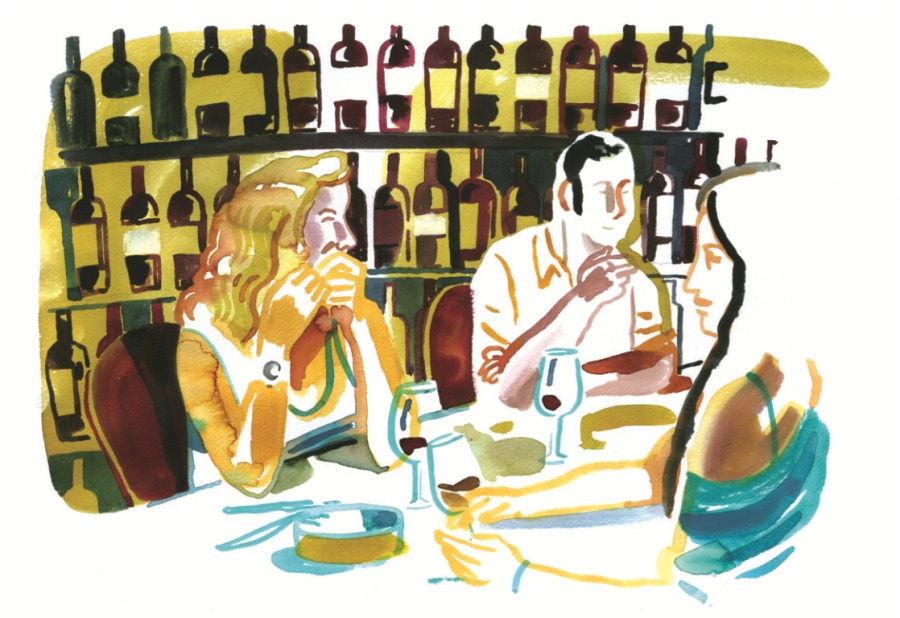
CHAPTER II
A restaurant in London
They met each other in Berlin many years ago. Eva was studying with an Erasmus grant, Tom was a photographer and Stefan had just started to work in the kitchen in a pizzeria. The three of them shared a flat in the district of Kreuzfeld. Liv came along later. She worked in a small art gallery. They formed such a close friendship that when that phase had come to an end they decided to carry on meeting up every two years in a different location. Since then they had met up in Paris, on the Greek islands, in Helsinki and the last time in London where Stefan, after having learned the ropes in kitchens from all over Europe, had opened Gare de Lyon, his own restaurant.
Gare de Lyon combined the cosy charm of a traditional English inn with innovative decorative nuances. The wine cellar was visible behind a large glass curved fish tank which revealed hundreds of delicately lit bottles. Stefan had kept the best table right next to the wine cellar.
Liv and Tom were the first to arrive. Stefan came out to welcome them dressed in this chef’s whites. He was radiant. Things were starting to go very well for him in Gare de Lyon and that night he was going to be able to celebrate it with his best friends. The door opened again, it was Eva. Now they were all there.
Half an hour later they drank a toast to meeting up again accompanied by an array of delicious starters. Stefan had wanted to surprise them with dishes inspired from their respective cuisines that would take them to unknown places. In honour of Liv he had prepared his take on the famous dish The Sea created by a renowned restaurant in Copenhagen.
Its penetrating sea flavours transported them to a wild Nordic cliff top. With Tom in mind, he prepared small burgers according to the new North American cuisine with gribiche sauce and a dressing based on cooking apples. And, for Eva, his idea consisted of a cherry gazpacho, fresh cheese and Iberian cured ham, a contrast of sensations between traditional and the most avant-garde.
Stefan suggested a different wine for each new dish and the result was a journey through the world’s wine-producing landscapes. The English wine market has always been characterised as being extremely cosmopolitan and the wine cellar in Gare de Lyon, with such a vast selection, was a true reflection of the knowledge and the desire for discovery shown by the London consumer.
The best was yet to come.
“Are you ready for an explosion of local tradition?” Stefan asked standing in the kitchen door.
He came out with a hostess trolley upon which was a large tray with a silver lid. He removed the lid and revealed a juicy joint of roast beef, English style, accompanied by oven-baked pears, potatoes and pudding. The roast was surrounded by a vast selection of small sauce boats containing blueberry, rosemary, onion, mint and redcurrant sauces.
Stefan went to get a decanter filled with red wine which he had kept especially for the occasion. This was his trump card to impress his friends. Upon smelling it they all knew they were in the presence of greatness. Its aromatic complexity was a symphony of spicy notes and fine wood, ripe wild fruit jam, with a pure and deep freshness. After taking the first sip silence reigned. Outstanding in character, a timeless distinction. Volume and strength, whilst being as delicate as silk at the same time. Such a balance seemed almost impossible. Genuine rusticity hand-in-hand with elegance. It was a wine that took you by surprise and at the same time touched the palate full of vigour. A wine for drinking and for being the topic of conversation. What had that marvellous thing been? One hour and two bottles later Stefan made them a tempting suggestion: “I’ve just had a crazy idea, the next time we meet up, why don’t we go to the place where this Eguía Reserva is from that leaves us so speechless?” That was how a night in England started this journey which took four friends to the banks of the Ebro.
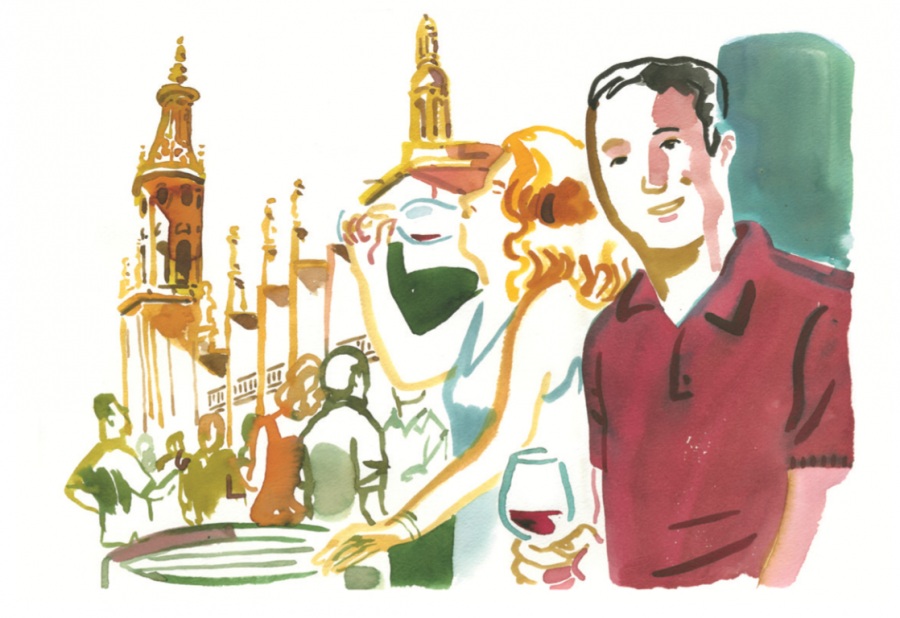
CHAPTER III
The streets of Logroño
Liv and Stefan got into the car and crossed the river using the nearest bridge which was approximately seven or eight kilometres from there. By following Eva’s directions by mobile they didn’t take long to reach the south bank. Amongst hugs and laughs, the four were together again and the sun was shining. The first day in the La Rioja had started in the best possible way. Eva knew that the good weather had an appeal that her friends attached great value to. In the flat that they shared in Berlin they would rush out to the terrace when the sun came out, even if just for a few minutes. And in the spring she was struck by how everyone came out of the shops, cafés and even the offices to make the most of the fresh air even when there was just a glimmer of good weather. So she wasn’t at all surprised to see how happy Liv, Tom and Stefan looked under the Riojan sky. And it was only the first day.
It was already late morning and they took the road to Logroño, the region’s capital. They parked in the modern part of the city and a short walk took them to the old quarter where a large art deco building seemed to be welcoming them. It was the famous San Blas market where there was a constant stream of people going in and out laden with shopping bags and trolleys. Inside they were met with a vast array of sounds and colours. The central island, which had vegetable stands, was surrounded by small shops selling meat, fish, salted fish and pulses.
“What I would cook with all of this!” Stefan exclaimed.
“And how I would enjoy eating it!” Tom answered. “Aren’t you hungry? I’m ravenous.”
“Don’t worry Tom, in five minutes you’ll be sorted” Eva said as she showed him to the exit.
Outside the market the medieval part awaited them full of life, and something else for which the city is famous: the tapas bars in the historical centre. In the streets of Laurel, San Agustín, San Juan and Portales fifty establishments put their miniature culinary delights on display. Each one specialises in two or three unique tapas which adds to the feeling of following a gastronomic route.
“Where shall we start?” Tom and Stefan said in unison, visibly moved by the prospect of a feast of tapas concentrated in just two hundred metres.
Cazuelitas, rotos, zapatillas, oreja. Solomillos, sorditos, bocatitas.
Zorropitos, matrimonios, wonderbras. The range was immense, the names fun, the flavours fantastic. Stefan enthused over the essential power of the famous tapa known as champi: three large griddled mushrooms are placed on a slice of bread with a prawn at the top and are dressed by a sauce which brings out the flavour of the entire tapa. Tom was overcome by the cojonudos, a powerful partnership between a slice of chorizo, a fried quail’s egg and a strip of hot red pepper. The glasses of wine, stimulating conversation and the warmth of the people added the finishing touch to the experience. It had been the best way of starting their week in La Rioja.
“What I like most about this region is how it has known how to combine modernity with tradition” Eva explained between bars. “This is particularly noticeable in the cuisine; there are recipes that have been around forever alongside really innovative concoctions. In the bars in Laurel street, for example, you see ancient flavours and unique tastes, presentations that my great-grandmother used to do with dishes that could be served in Stefan’s restaurant.
“I think I’m going to sell Gare de Lyon to open a place here!”
Stefan said suddenly. Suddenly Liv pointed towards the shelf in the bar they were in and triumphantly exclaimed: “Bottles of our favourite wine!”
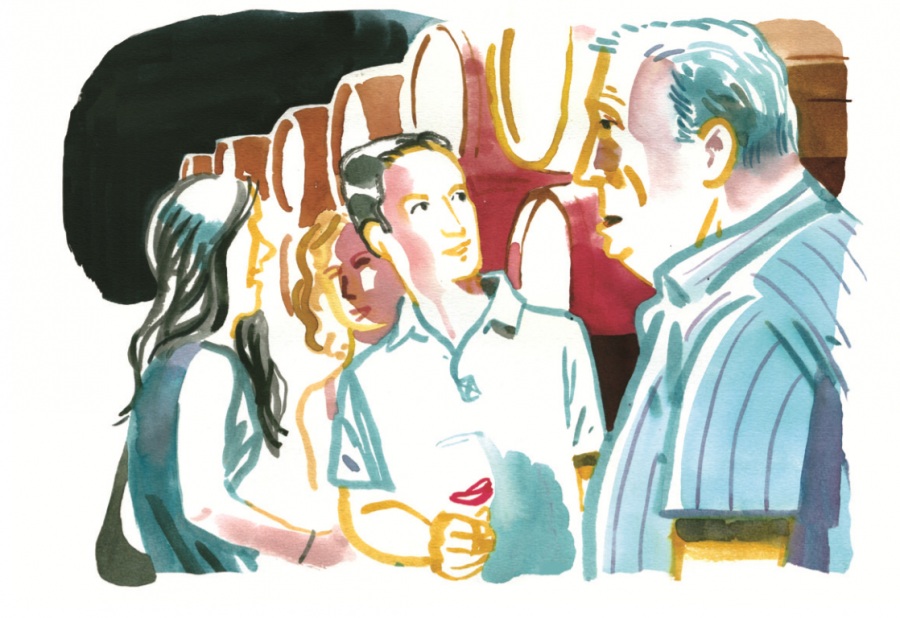
CHAPTER IV
The surprise
The label with the outstretched hand and the motto “in vino veritas” was unmistakeable. Eguía,“ The truth and nothing but the truth”, Crianza. One of the wines from the same family as the legendary reserva that they had drunk in London. Clear, fresh and with a rounded flavour the crianza was perfect for accompanying a tapa of sirloin with pepper. Two minutes later they were enjoying the balance, authenticity and clarity of Eguía.
“I think it’s the right time to tell you all something” Eva said enigmatically. “I can’t wait any longer, I’ve got a surprise for everyone.” The others looked at her expectantly.
“A few months ago, when I was preparing this trip, I had an idea” she continued. “I managed to get the telephone number for the Eguía Winery, gave them a call and asked if it would be possible to visit the winery in Elciego. They’re expecting us tomorrow.”
The joyous cry that the other three let out in unison could be heard in the five or six bars nearest to them. It was a fabulous idea for getting to the very heart of the emotional journey that they were starting.
The next day the four friends left Logroño to head for Elciego. They crossed the Ebro over the old city stone bridge and in a few minutes they had reached Rioja Alavesa. En route they had beautiful views of the vineyards framed in the distance by the imposing Cantabrian mountains.
Dedicated to wine-making for centuries, Elciego is a village characterised by ochre colours and solid houses amongst which the graceful towers of San Andrés church stand out. Beyond the centre of little streets and squares, palaces and baroque facades, its image has been enriched in recent years with the construction of new wineries exuding spectacular architecture. Elciego is home to modern Riojan wine since it was here in around about 1870 when crianza wine was introduced following the Bordeaux style.
In the Viña Eguía winery, Javier and Chema, two of the winery managers, were waiting for them in the spacious square which acted as a reception area for the entire winery. At the rear a complex of buildings spread out in different shapes and sizes. Further away, green vine shoots peaked up from behind the wall of the property. After a warm welcome Javier took them to the first building.
“When it’s time for the grape harvest, he explained, the first step is taking the grapes to the wine press area where the processes of selection, de-stemming and de-silting take place. After this we take the resulting must to here” and he opened large gates. On the other side a huge hall appeared with high ceilings and a long central aisle. Both sides were lined with dozens of steel vats.
“We could say that the wine, as such, is born in this room. Fermentation takes place in these vats. Once finished, the process follows different paths depending on the type of aging required: new wine, crianza or reserva.
“This is really exciting! Live exclaimed. Each time I have a glass of Eguía I’ll remember the secrets of its preparation.”
“There’s no secret, Javier answered. It’s the combination of knowledge, practice, tradition, innovation and a great deal of respect for natural processes. Quite simply it’s a question of following the truth of nature.
The visit continued underground, in an enormous open room where thousands of oak casks were resting. Here, far away from the hubbub outside, the wines evolve enveloped in the tranquillity of the wood.
“What are your plans for the next few days?” Javier asked at the end of the tour.
“We want to get to know this region inside out. And enjoy the wine, naturally” Eva answered.
“I’m going to give you some useful tips” Javier took them to the offices. “And, of course, some boxes of Eguía Crianza so that you continue to enjoy yourselves with our wine.”
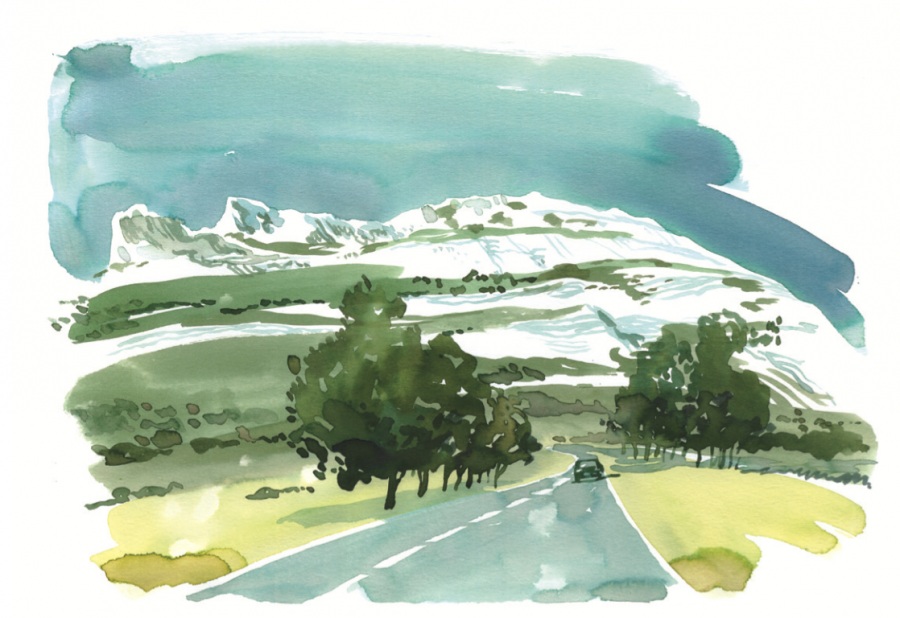
CHAPTER V
An unforgettable week
“Do you see the course of the Ebro? It follows a winding route amongst the vineyards. Rioja Alta is on the right and Rioja Baja on the left and, just in front, below us is all of Rioja Alavesa. Down below it’s possible to make out Elciego. And in the distance, at the other end of the valley, are the mountains of Demanda, Cebollera and Cameros.”
It was a very clear day and the clarity made it easier to follow the description that Eva was making from the Balcón de la Rioja, an exceptional viewpoint which literally appeared to be hanging from the rocks of the Cantabrian mountains.
They had been on the go non-stop for seven days. After their visit to the Viña Eguía winery, they had followed a complete route which took them to all the corners of the region. There was so much to choose from and, to start, they opted for the most natural and wild side of the area. They visited the valley of Ezcaray, with its hamlets and green ravines. They walked through the mountains in the Iberian range, they covered the vast beech woods in the Cebollera mountains and they even reached remote abandoned villages. The most unknown and hidden part of La Rioja offered them an exceptional landscape. From the highest mountains they could even see the peaks of the Pyrenees, still capped with snow in the month of June.
In the Cameros mountains they went into the Ortigosa caves and followed the canyon route of the river Leza, which took them to striking countryside with vultures flying above.
“With all this walking I’m going to lose my highly regarded well-fed chef’s figure” Stefan gasped when they reached the rural accommodation they were staying in. “And, he added: I suggest a change of plan, tomorrow cities and tapas again!”
A second phase of their journey had thus begun which would take them to Alfaro, Calahorra, Arnedo, Nájera and several churches, city walls, chapels and palatial houses en route.
In the monastery of San Millán de la Cogolla, very close to the town of Nájera, they spent hours absorbed in its thousand-year-old culture. The monastery study still has some of the most important medieval codices in Europe. That day, while her friends went for lunch, Liv preferred to stay behind and have a look through ancient manuscripts. They were her great passion.
“I’ve made a marvellous discovery” Liv said when they met up later. Listen to this:
“I want to write a prose in layman’s terms, that the people use to speak with their neighbour, indeed I’m not learned enough to do so in Latin; I believe a good glass of wine will be sufficient.”
“It’s one of the first verses in Spanish, she added, written in the 12th century by a monk from this monastery called Gonzalo de Berceo, and in it he already speaks about wine!”
“As in all regions with a strong wine-making tradition, Eva explained, here the development of vine growing in the Middle Ages was closely related to monastic orders.”
Amongst ancient stories and future plans they spent their last days visiting wineries, vineyards, landscapes and as Tom commented amused, “hundreds of bars to raise a toast to Berceo and all those who had known how to praise wine”.
And that was, in essence, how an unforgettable week had been spent. The journey was coming to an end.
When they came down from the Balcón de la Rioja viewpoint they caught sight of one of their favourite villages: Laguardia. They decided to lose themselves, as they had done so days earlier, amongst the cobbled streets and the peculiar caves ensconced throughout the medieval quarter of this town, head of Rioja Alavesa.
They had just reached the town through one of the entrances in the city wall when Eva got a call from Javier.
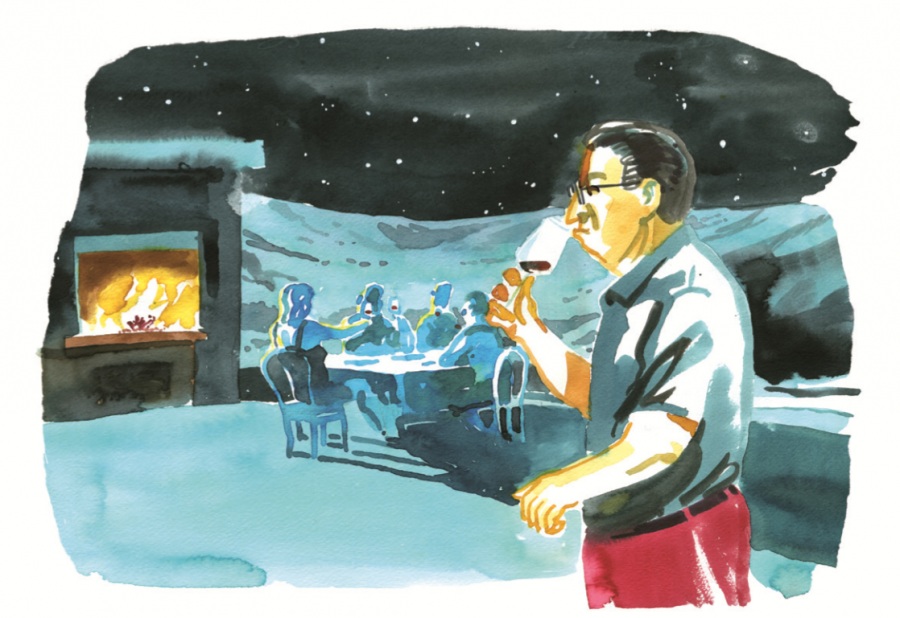
CHAPTER VI
Farewell dinner
“What are you doing this evening?” Javier asked at the other end of the phone. “We’ve not decided on anything. Why?” Eva answered.
“What about a gastronomic immersion in products from the area to finish with a very special dinner?” “And, of course with a perfect combination of wine and cuisine.” “In Viña Eguía, in two hours.”
They didn’t give it a second thought, they all thought it would be the perfect end to their trip. After a walk through the old quarter of Laguardia, they headed off to Elciego.
The road wound through ravines, hillsides, small valleys and cultivated terraces. The geography of Rioja Alavesa, alongside the work of its inhabitants, who had become true landscape sculptors, has created a privileged location for vine growing. A mosaic of tempranillo grape vines which express personality, effort and commitment with the promise of future pleasure.
Whilst arriving at their destination, oblique rays of sunshine bathed the vineyard. It was the last dusk of the journey.
The wine tasting room in Viña Eguía was already prepared. Javier, Chema and another nine or ten people chatted animatedly around various high tables. On one side of the room there were several bottles prepared of the house wines.
Whilst Javier made the introductions his father entered, Julián, owner of the winery, one of the key people for understanding today’s wine in Rioja Alavesa.
“Downstairs everything is ready for the most important thing” Julián commented to the guests. “However, first of all we’ll have some starters which are going to convey a great deal of the character of this region to you, which is a harmony between tradition and modernity.
This was the start of a banquet of small dishes which ranged from ancient flavours to the new trends being pursued by gastronomy in La Rioja. All of them were characterised by extraordinary raw materials which is the pure essence offered by the valley and mountains which flank the course of the river Ebro.
Diverse culinary delights emerged on different trays. Firstly, the authenticity of some excellent products with almost no preparation: juicy vegetables cooked just perfectly, succulent cured meats, the overwhelming simplicity of stuffed peppers...
This was followed by small portions based on ancient recipes, fruit of wise cuisine such as braised meat, sautéed egg, stews revealing patience and a rustic distinction. Finally, avant-garde preparations, from the present day, which express the balance between the quality of a clear origin, historical heritage and a touch of provocation. To accompany these starters they drank Eguía Crianza, fresh on the palate, lively and refined and Eguía Reserva, deep, noble and complete which decisively enhanced the most intense flavours.
“Now for the best part, everyone outside to eat!” Julián exclaimed upon finishing.
Outside night had already fallen. A row of small torches lit up the short path which led the group to a large porch.
On one side a large bonfire burned on the stony ground. A few metres further away was the start of the vineyard.
“If there is something which defines our gastronomy, Julián explained, it is what we’re about to prepare and eat: lamb cutlets in vine shoots. And of course, using the vine shoots grown here, from the Viña Eguía vines.”
After a few minutes the fire had been reduced to embers and everyone helped to spread out dozens of small lamb cutlets over the grill. They grilled them on both sides and they were soon ready for eating. Julián was absolutely right: the tender lamb’s meat, flavoured by cooking it on the fire with the vine branches produced a unique flavour, a tender delight which was unforgettable: it was the sensorial epitome of this wine region.
The Eguía Gran Reserva accompanied the moment. Genuine, personal, structured, it is a wine-making treasure which brings together character and truth.
The conversation flowed whilst the cutlets were being savoured. The dinner was strengthening friendships and forming new ties.
“It’s going to be difficult to better this dinner” Tom whispered to Eva. And he added:
“Although I have an idea as to how we can try something at least as good.”
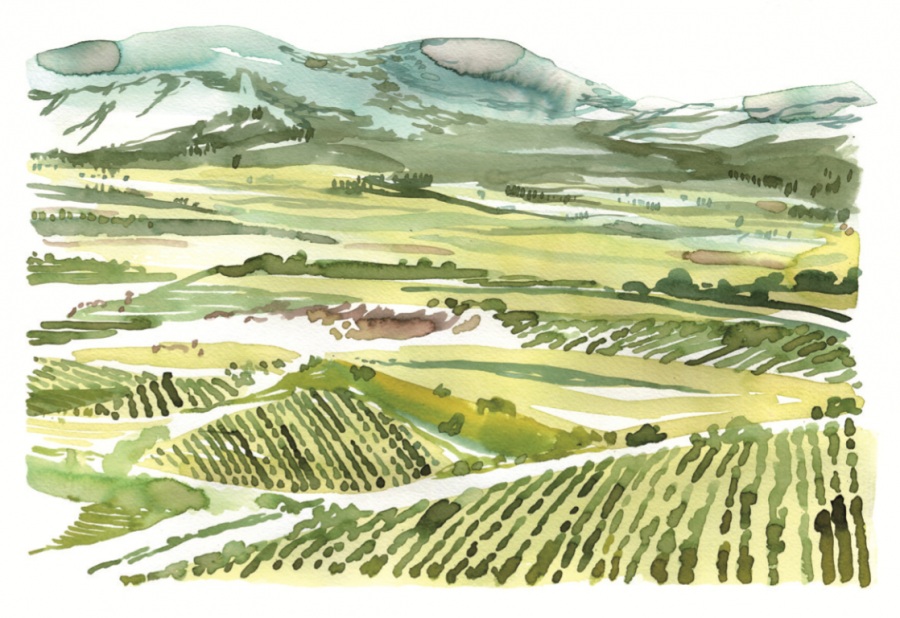
CHAPTER VII
Destination Nueva York
Since they had arrived in La Rioja Tom, who already had vast experience as a photojournalist, had been taking photos non-stop. The region, the monuments, the people, the wine places, the dishes, the vines: He managed to find an iconic, beautiful, interesting or memorable side to everything. He had brought professional, but simple, equipment with him; he was convinced that the most important thing is the photographer’s eye. And with a good eye he had managed to capture excellent images.
He was so pleased that one day, in the middle of the trip, he decided to send some sample copies to his representative in Chicago. From that moment on everything seemed to go at breakneck speed. The next morning Jay, the representative, called Tom.
“This is one of the best works you’ve done in your life Tom” he said. “You seem to have found a place which brings out the best in your creativity.”
“Yes, I’m really happy with it. But in any case, are you not exaggerating? I only took a few shots” Tom said.
“That’s what I mean”, Jay said, there are only 10 images but they are incredibly powerful. And I’m not the only one who thinks so. Are you sitting down?”
“Why?” Tom answered laughing.
“The International Center of Photography is going to propose that you hold a monographic exhibition of this series. For next year, as part of a new programme called ‘Landscapes of the world’.” This is a unique opportunity, Tom. You’ll have to take many more photos of this place. This is unstoppable.”
The dinner in Viña Eguía was drawing to a close. After a dessert of curd ice cream the coffees and liqueurs arrived. Tom took advantage of a brief moment of silence and got up from his seat whilst chinking his glass with a piece of cutlery. Everyone stared at him intently.
“There is something I would like to share with you, he said, because to a certain extent you are, and will be, participants. I’ve been given the chance to hold an exhibition in New York for work which still in the early stages but which has been very successful: the photos that I’ve been taking over the last few days here.”
He took out a folder from his bag and gave it to Eva. It contained several photos. Eva handed them out to everyone.
“I’ll have to return for the grape harvest and later in the autumn to take new shots: the grape picking work, the activity in the winery, the autumn colours”, Tom continued. “Later, during winter I’ll prepare all the material.”
“And when is the inauguration?” Javier asked.
“In April, and I hope that you’ll come and all of you as well” Tom said pointing to his three friends. “And to make this a reality I’ve thought of something.” He then explained his idea to them.
It seemed that the deal offered to Tom by the museum went beyond the exhibition and covered the possibility of organising parallel activities.
He had carte blanche for organising the exhibition, the inauguration and any other activity that he wanted to carry out in relation to his work. Tom hadn’t taken long to think of what he wanted to do. He would prepare a special inauguration inspired by Riojan flavours. After all, was his photographic work not documenting that region? Well what could be better than opening the exhibition with a large bar filled with tapas and wines. Moreover, on a weekly basis he would organise a dinner for selected guests during which they would be offered delicacies as delicious as those served that night in Viña Eguía.
“If you want, it would be great if you were in charge of the gastronomic part” he said looking at Stefan.
After this he turned to Julián and Javier and asked: “What would you say if we had Eguía as the reference wine both during the inauguration and the dinners? I think that to convey the truth shown in these images there is nothing better than this truly authentic wine.”
After ten months, Eva, Liv, Stefan, Tom and their friends from Viña Eguía met up in a modern exhibition room in New York. But that’s another story.

